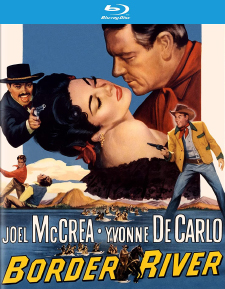Border River (Blu-ray Review)

Director
George ShermanRelease Date(s)
1954 (March 28, 2023)Studio(s)
Universal-International (Kino Lorber Studio Classics)- Film/Program Grade: C+
- Video Grade: A
- Audio Grade: A-
- Extras Grade: C+
Review
As its bland title suggests, Border River (1954) is a very routine Western enlivened a bit by star Joel McCrea’s screen presence and attractive Technicolor photography; according to some sources it was the last Hollywood feature photographed (by Irving Glassberg) in the 3-strip process.
In the last weeks of the Civil War, Confederate Major Clete Matson (McCrea) rides across the Rio Grande into Mexico, hotly pursued by Union soldiers. Wounded, he lands in Zona Libre, a hopelessly corrupt but effectively self-governing zone where American deserters and cattle rustlers find refuge, despite the dictatorial nature of its ruler, General Eduardo Calleja (Pedro Armendáriz), who has citizenry routinely executed.
Matson is on a mission to buy guns and other war supplies using $2 million in Union gold stolen from a bank in Colorado. Calleja welcomes Matson and his proposal with open arms but, rather illogically, Matson immediately antagonizes the general by openly courting his paramour, Carmelita (Yvonne De Carlo). This serves only to generate alleged suspense as to whether Calleja’s growing jealously will only ensure the inevitable double-crossing once the gold arrives.
The screenplay, credited to William Sackheim and Louis Stevens, is rife with missed opportunities. The Zona Libre, or “Free Zone” was an actual place in the Mexican state of Tamaulipas, and the film sets up interesting tensions among the expatriate Americans from both North and South that never materializes meaningfully, and the actors playing these parts are generally bland bit players. More intriguing is the idea of Matson risking his life for a lost cause, as the film implies the Confederacy is on its last legs, that the end of the war is imminent. Had Matson risked everything, lives lost for nothing might have given the film a little weight, but this, too, is dropped.
What’s left isn’t much. McCrea’s great strength in Westerns was as a man of unassailable principals, as in Sam Peckinpah’s great Ride the High Country (1962). Matson’s foolish romancing of Carmelita suggests the script may have been written with a more roguish actor in mind; a suave dandy type McCrea definitely was not.
Sackheim was a journeyman writer who moved into television by 1955, eventually producing shows like Gidget and The Flying Nun. Later in life he co-wrote First Blood with Michael Kozoll, from David Morrell’s novel, but star Sylvester Stallone may have extensively rewritten that script. The even older Stevens has credits dating back to at least 1920, and by the sound era wrote mostly higher-end program pictures, especially Westerns.
Likewise, director George Sherman was a prolific director of B-Westerns, primarily at Republic, followed by more oaters at Columbia and Universal. Like William Witney, he was no slouch but no great auteur, either. Fast and reliable were their strengths, with Sherman directing more than a hundred features, his last being the John Wayne vehicle Big Jake (1971), a lesser star vehicle.
McCrea was one of the great, somewhat underrated stars, impossibly handsome in his youth he segued into a wide range of films, including several great comedies for writer-director Preston Sturges. From his middle age McCrea mostly stuck to Westerns. He was by this time a multi-millionaire with an enormous ranch; similar to actor Ben Johnson, McCrea was the Real Deal. But the ordinariness of Border River lets him down.
Kino’s Blu-ray offers a virtually flawless transfer presumably derived from the original black-and-white separations, with vibrant colors and impressively sharp resolution throughout. (I noticed a single, fleeting misaligned shot, but that occurs during the middle of a stunt where the camera appears to have been bumped.) The DTS-HD Master Audio (2.0 mono) is excellent, and supported by optional English subtitles. The disc is Region “A” encoded.
The film is presented in 1.37:1 standard frame, even though it began shooting in June 1953 for release in January 1954, by which time 1.37:1 releases were increasingly rare. However, the framing throughout suggests it was indeed shot this way. Maybe because this was already in Technicolor, U-I figured it didn’t need the additional incentive of wide screen as a selling point, or maybe Universal realized the film would make most of its money outside big cities where the transition to widescreen was moving more slowly—but that’s pure speculation on this reviewer’s part.
Other than a brief (1:24) trailer, the lone extra is an audio commentary track by film historian Toby Roan. Like Roan’s other commentaries, it’s completely dominated by cast and crew biographies and filmographies. Movies like Border River appeal almost exclusively to Western genre buffs, people already familiar with this stuff, information widely available on the Internet, and which in any event circumvents much direct discussion of the film itself. Boxes of primary research materials on Border River are available at places like the Universal Collection at the USC Cinema-Television Library, a source wonderfully mined for other U-I titles by commentators like Tom Weaver. Personally, my feeling is if you’re going to do one of these things, it’s not difficult to dig a little deeper.
Of course, a film like Border River hardly seems worth the effort. It’s not a bad Western, but it is disappointingly routine.
- Stuart Galbraith IV

